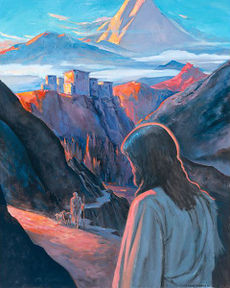Þöglu árin í ævi Jesú

Það er engin heimild í Biblíunni um hvað Jesús hafði fyrir stafni frá tólf ára aldri, þegar hann var í musterinu í Jerúsalem að ræða við rabbína-presta, fram til þrítugs þegar hann birtist við ána Jórdan til að láta skírast. Þessi ár á milli – hin svokölluðu „þöglu ár“ – eru mikilvægustu árin í lífi Jesú vegna þess að á þeim árum varð hann sá sem hann var og undirbjó sig fyrir hina palestínsku köllun sína.
Jesús fæddist líklega á árunum á milli 8 f.Kr. og 4 e.Kr., varði bernskuárum sínum í Palestínu og gæti hafa flutt til Memfis í Egyptalandi stuttu eftir fæðingu sína og búið þar í þrjú ár. Margar goðsagnir frá Bretlandseyjum greina frá því að afabróðir hans Jósef af Arímaþeu, tinkaupmaður með skipaflota, hafi reglulega siglt til Bretlandseyja og farið með hann til Glastonbury á unga aldri, á aldrinum sjö til tólf ára, að mennta sig við Drúida-háskólana sem voru í miklum blóma á þessum tíma.
Við fregnum af honum næst í musterinu tólf ára að aldri í tilefni páskanna og síðan vitum við ekki meira um hann í Biblíunni fyrr en um þrítugt. Fræðimenn hafa gert ráð fyrir að hann hafi búið í Palestínu á þessum tíma að fást við smíðar. Hins vegar eru engar staðreyndir til að styðja þá kenningu.
Sannanir frá búddhískum handritum
Forn búddísk handrit sem segja að Jesús hafi eytt þessum „týndu árum“ í austri. Þessir textar voru upphaflega skráðir á palí, heilagt tungumál Theravada búddistakanónunnar. Síðar voru þau þýdd á tíbetsku. Handritin fundust í nóvember 1887 af rússneska blaðamanninum Nicolas Notovitch í Himis, þessu búddaklaustri nálægt Leh í Ladakh. Árið 1894 gaf Notovitch út þýðingu á þessum texta sem „Líf heilags Issa“.

According to the manuscripts, at age thirteen Jesus departed Jerusalem with merchants and set out towards the Sind “with the object of perfecting himself in the Divine Word and of studying the laws of the great Buddhas.” At age fourteen he crossed the Sind, a region in present-day southeast Pakistan in the lower Indus River valley. He then established himself among the Aryas.
Jesus’ fame spread and the Jains asked him to stay with them. But he went instead to Juggernaut, India, “where the white priests of Brahma made him a joyous welcome.” The priests “taught him to read and understand the Vedas, to cure by aid of prayer, to teach, to explain the holy scriptures to the people, to drive out evil spirits from the bodies of men, restoring unto them their sanity.” Between the ages of fourteen and twenty Jesus spent six years at Juggernaut, Rajagriha, Benares and other holy cities.
Eventually, Jesus became embroiled in a conflict with the Brahmins and Kshatriyas (the priestly and warrior castes) because he taught the holy scriptures to the lower castes. His enemies plotted to kill him. And at age twenty-one he left Juggernaut by night and went to the foothills of the Himalayas in southern Nepal, the birthplace of Gautama Buddha. Between the ages of twenty-one and twenty-seven Jesus spent six years in Nepal, where he mastered the Pali language and became “a perfect expositor of the sacred writings.”
According to tradition, sometime during his sojourn in the East Jesus also traveled to Ladakh, Rajputana and Kabul in present-day Afghanistan. Between twenty-seven and twenty-nine he left the Himalayas and journeyed West, preaching along the way. He passed through Persia, where he rebuked a false priesthood of Zoroastrianism, who in turn cast him out of their town in hopes that he would fall prey to the wild beasts. Finally at age twenty-nine, fully prepared for his mission, he returned to Palestine.
Mikilvægi þöglu áranna
In those lost years Jesus walked a path of discipleship under the great lights of the East. He sought the perfecting of his heart and mind, and although he was born an avatar, he still had to take the necessary human footsteps. Jesus had to walk the path to accomplish his soul’s integration with the Word in preparation for his baptism, his transfiguration, crucifixion, resurrection and ascension, and he had to work to internalize and bring forth the fullness of his Christhood. And if he had to do it, we also have to do it.
El Morya points out that the suppression by the churches of the knowledge of Jesus’ lost years has “hurt the younger generation more than all others, because they have had no one to equate with from the years twelve to twenty-nine. In those very important years from twelve to eighteen, when all of the burdens and temptations of life come upon them, they have not seen the figure of the one who became the master and who now is ready to show them the way.”[1]
Sjá einnig
Til frekari upplýsinga
Elizabeth Clare Prophet, The Lost Years of Jesus: Documentary Evidence of Jesus’ 17-Year Journey to the East
Hartmann Bragason, Austurlenskar rætur kristninnar. Upprunalegar kenningar frumkristninnar og guðfræði nýja tímans. Bræðralagsútgáfan, 2022.
Heimildir
Elizabeth Clare Prophet, 4. október, 1987.
Elizabeth Clare Prophet with Annice Booth, Mary Magdalene and the Divine Feminine.
- ↑ El Morya, Pearls of Wisdom, vol. 25, no. 70.
